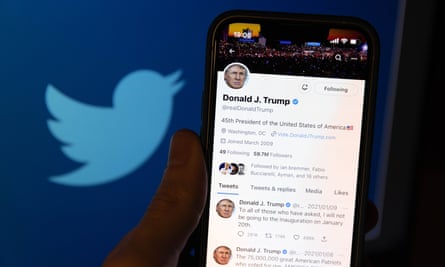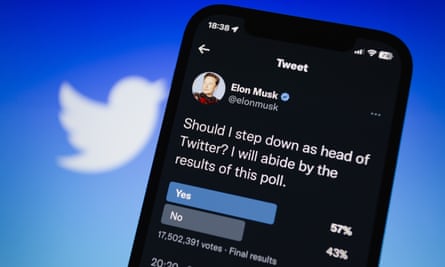When Elon Musk walked into Twitter’s offices on 26 October carrying a sink, one day before he bought the platform for $44bn (£38bn), it was the first sign that the tale of his ownership would not be a conventional one. “Let that sink in!” he tweeted. For everyone swept up in what followed – from thousands of Twitter employees to advertisers and critical journalists – it certainly has now.
Musk’s reign since has proved unpredictable and controversial, with the Tesla CEO losing the title of the world’s richest man in the process. Here are some of the standout moments from those eventful past 10 weeks:
Firing half the workforce
As soon as Musk took over Twitter he fired senior executives including: the CEO, Parag Agrawal; Ned Segal, the chief financial officer; and Vijaya Gadde, the head of legal policy, trust and safety. Days later he axed 50% of the company’s 7,500-strong workforce with affected areas including the communications team, the curation unit that helped counter disinformation and the human rights team.
More departures followed a bizarre episode in which Musk set employees a mid-November deadline to commit to working “long hours at high intensity” and being “extremely hardcore” or leave with three months’ severance pay. This led to the departure of a further 1,200 staff, according to one estimate. Musk now says Twitter has about 2,000 employees. About the same time, it was reported that Twitter had let go 4,000 contractors in fields including content moderation and engineering.
Responding to predictions of Twitter’s demise in late November, Musk tweeted: “Wasn’t Twitter supposed to die by now or something … ?” However, the platform, which has faced warnings of technical problems after letting go so many expert staff, did suffer an outage on 28 December that affected some users.
Musk said the firings were necessary because Twitter was losing $4m a day. That is an intimidating number for a business that must make payments of more than $1bn on the near-$13bn of debt that now sits on its balance sheet, as part of the takeover’s financing. Musk said in December that Twitter was facing a “negative cashflow situation of $3bn a year” but claimed the company should “roughly” reach cashflow break-even after his cost-cutting efforts.
Alienated advertisers and subscription setbacks
Musk admitted that Twitter had suffered a “massive drop in revenue” after the takeover, which he blamed on campaign groups lobbying advertisers about the future of safety and content guidelines under Musk’s leadership. The carmaker Audi, the drugs firm Pfizer and General Motors were among the brands that paused spending on the platform in the immediate wake of the takeover. This is a material issue for a company that made 90% of its more than $5bn in revenue in 2021 from advertising.
The ad freeze deepened in the wake of a botched relaunch of Twitter’s premium service, Blue, which resulted in a host of impersonators taking advantage of the chances to launch “fake” verified company accounts for just $8 a month. Companies affected included the pharmaceutical firm Eli Lilly & Co and Musk’s own Tesla, leading to the service being temporarily suspended.
Work is underway to repair the damage. Twitter is working with the World Federation of Advertisers, which says its membership represents 90% of global ad spending, on addressing advertisers’ concerns, plus Blue has been relaunched again without a resurgence of the fake account problem.
The new service offers verified status – via a blue tick or checkmark – for $8 a month or $11 a month on their iPhone. Musk believes mass verification is the best way to defeat vexatious spam accounts, one of his Twitter bête noires. Other perks promised by the subscription service include an edit button, a 50% reduction in the number of adverts in a user’s feed and the ability to post longer tweets.

Reinstating banned accounts
Musk has lifted suspensions on the accounts operated by Donald Trump, the British-American former kickboxer Andrew Tate – who had been banned for extreme misogynist posts, and was on Friday arrested in Romania on charges of human trafficking, rape and forming an organised crime group – and the Canadian psychologist Jordan Peterson, among others. The account of US rapper Ye – formerly Kanye West – was also reinstated but then suspended again after he tweeted an image of a swastika blended with a star of David.
At the same time Musk announced a new content policy of “freedom of speech, but not freedom of reach”, stating that “negative/hate” tweets would be “deboosted” and no adverts would appear near them.
The reinstatements were another sign of the inconsistent behaviour that would mark Musk’s reign, coming weeks after he said no decisions would be taken on reinstatement until a newly announced “content moderation council” had met. He blamed the apparent backtrack on unnamed “political/social activist groups”, accusing them of persuading advertisers to stay away.
Suspending journalists
In mid-December Musk contradicted his stance on freedom of speech by freezing the accounts of prominent tech journalists at CNN, the Washington Post, Mashable and the New York Times. He accused them of breaching a newly created Twitter guideline that barred users from publishing “live location information” that would “reveal a person’s location, regardless if this information is publicly available”. This guideline had been created as an apparent justification for suspending, @ElonJet, a Twitter account that had long vexed Musk by displaying the location of his private jet via publicly available information.
The journalists were reinstated days later, after Musk launched a poll on his own Twitter account that delivered a majority in favour of lifting the suspensions. But Musk’s targeting of journalists drew condemnation from the UN, the EU and campaign groups.
Also in December, Musk released internal Twitter documents to select journalists in a project dubbed the “Twitter Files”. The documents showed the internal process behind decisions to suspend Donald Trump’s account in 2021 and the platform’s response to the Hunter Biden laptop story. Another excerpt from the files raised questions about Twitter’s dealings with the Pentagon.

Dragging Tesla into it
Musk’s status as Tesla CEO is key to his fortune and had made him the richest person on the planet, before he lost the title to the luxury tycoon Bernard Arnault in December. The performance of the electric carmaker, in which Musk holds a substantial stake, has got worse as his interest in Twitter has grown. Musk’s involvement in the platform first emerged in early April with the revelation that he held a large shareholding in the business, followed weeks later by the deal to buy the company, which he initially walked away from – leading to legal action – before he returned to complete it two months ago.
In 2022, Tesla’s shares declined in value by 70% to $123. Some of this is Tesla-specific, such as slowing demand and fears over Covid shutdowns at its Chinese factories, but Musk’s repeated sales of Tesla stock to fund his Twitter purchase – despite saying in April he had no more planned – plus concerns that he is focusing too much on the social media platform have also rattled investors.
“Musk has lost credibility with the broader investment community as broken promises (selling stock again and again and again ….), the Twitter fiasco, opening up the political firestorm on Twitter, and brand deterioration for Musk and Tesla has led to a complete debacle for the stock,” said Dan Ives, the managing director at the financial services firm Wedbush Securities.

“Resigning” as boss
Musk said on 20 December he would resign as the CEO of Twitter “as soon as I find someone foolish enough to take the job!” His announcement followed a poll on his Twitter account in which users voted decisively in favour of him standing down. The pledge also followed court testimony in November in which he said he expected to “reduce my time at Twitter” after an “initial burst of activity”. Whoever takes the job will be running a globally influential social media platform with more than 250 million daily users. But with a very demanding, and impulsive, owner.
“One of the first things I said after the acquisition closed was like, ‘we’re gonna make a bunch of mistakes but then we’ll try to recover from them quickly,’ and that’s what we’ve done,” Musk said on the All-In Podcast, released days after his announcement he was stepping down. But for the Tesla CEO, the biggest mistake – with a lower chance of full recovery – might have been buying Twitter in the first place.